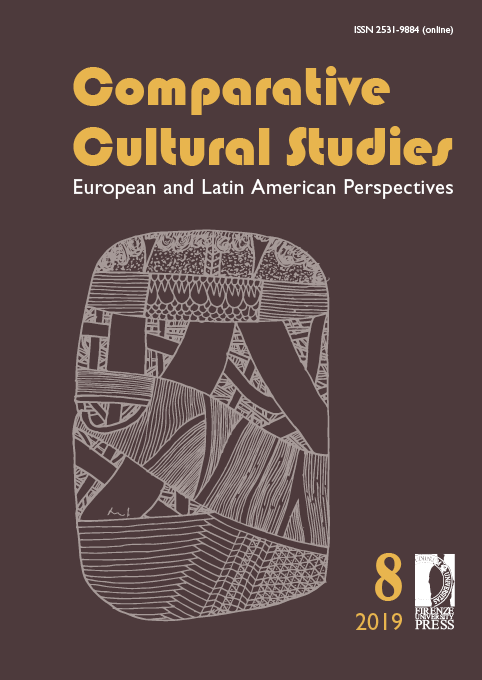Processi di inclusione e di esclusione nelle scuole multiculturali. Un’indagine preliminare nel territorio toscano
DOI:
https://doi.org/10.13128/ccselap-10867Palabras clave:
Hate speech, multiculturalism, interethnic relations, inclusive school communitiesResumen
The most important challenge of multicultural societies is to identify new practices to transform the diversity in a learning and inclusive opportunity, thus counteracting the emergence of violent radicalization. Starting from this perspective, the contexts of life - included the scolastic context – require professionals to acquire and develop specific multicultural competences to handle this complexity; the intercultural relations do not always evolve in positive contacts, which can lead to negative attributions towards the “other”, which, perceived as “different”, could lead to hate speech, ostility in the relationship, and violence. For the Italian Schools, which work in highly multicultural context, the above is translated into a double challenge: 1) promoting the mutual identification and the networking with other institutions in the local community, 2) for teachers, facilitating the learning processes for students coming from other cultures and manage interethnic conflicts, which may arise in the classroomes. At this purpose, the present work aims to explore discrimination episodes detected in schools with highly multicultural complexity in order to analyze the practices used by teachers to cope with these episodes and to promote educational settings and inclusive community. The qualitative analysis of the materials produced by participants, allow to detect two main patterns of meaning: the interethnic relationships at schools, the competence of the multicultural teachers. Moreover, the critical reflection on the main themes, which concern the multicultural schools, may promote learning processes based on the experience. The present approach will likely allow to define useful strategies to improve the inclusive process, inside and outside the classes.
Descargas
Citas
Benesch, S. (2014). Defining and diminishing hate speech. Freedom from hate: State of the world’s minorities and indigenous peoples, 18-25.
Braun, V., & Clarke, V. (2014). What can “thematic analysis” offer health and wellbeing researchers? International journal of qualitative studies on health and well-being, 9.
Carnagey, N. L., Anderson, C. A., & Bushman, B. J. (2007). The effect of video game violen-ce on physiological desensitization to real-life violence. Journal of Experimental Social Psychology, 43, 489–496. https://doi.org/10.1016/j.jesp.2006.05.003
Chakir, K. (2016), Dal discorso dell’odio al discorso al discorso del rispetto nelle scuole d’infanzia. Encyclopaideia XX (46), 120-142, 2016, ISSN 1825-8670Chong, D. (2006). Free speech and multiculturalism in and out of the academy. Political Psychology, 27(1), 29-54.
Cottrell, C. A., & Neuberg, S. L. (2005). Different emotional reactions to different groups: a sociofunctional threat-based approach to” prejudice”. Journal of personality and social psychology, 88(5), 770.
Craft, M. (2017). Teaching in a Multicultural Society: the task for teacher education. Routledge.
Davidson, T., Warmsley, D., Macy, M., & Weber, I. (2017). Automated hate speech detection and the problem of offensive language. In Eleventh International AAAI Conference on Web and Social Media.
Fabbri, L., & Romano, A. (2017). Metodi per l’apprendimento trasformativo. Casi, modelli, teorie. Roma: Carocci.
Fook, J., & Askeland, G. A. (2007). Challenges of critical reflection:‘Nothing ventured, nothing gained’. Social work education, 26(5), 520-533.
Gagliardone, I., Gal, D., Alves, T., & Martinez, G. (2015). Countering online hate speech. Unesco Publishing.
Greenberg, J., & Pyszczynski, T. (1985). The effect of an overheard ethnic slur on evalua-tions of the target: How to spread a social disease. Journal of Experimental Social Psy-chology, 21, 61–72. https://doi.org/10.1016/ 0022-1031(85)90006-X
Haslam, N., Rothschild, L., & Ernst, D. (2000). Essentialist beliefs about social categories. British Journal of Social Psychology, 39(1), 113-127.
Leets, L. (2001). Explaining perceptions of racist speech. Communication Research, 28, 676–706. https://doi.org/10.1177/009365001028005005
Miller, J.A. (1989), Ekstimnost. Problemi, 27(5), 33-46.
Orefice C. (2016). Fomentar la investigación, la formación y el desarrollo de programas sobre el campo de la diversidad cultural: el Proyecto Europeo GOVDIV. In: F. Gerva-si (coordinador). Diversidades. Perspectivas multidisciplinarias para el estudio de la interculturalidad y el desarrollo social, México: Ediciones Universidad Autónoma de Coahuila - DeLaurel, pp. 461-478.
Soral, W, Bilewicz, M., & Winiewski, M. (2018), Exposure to hate speech increases prejudice through desensitization. Aggressive Behavior. 44, 136–146.
Van Overwalle, F., & Jordens, K. (2002). An adaptive connectionist model of cognitive disso-nance. Personality and Social Psychology Review, 6(3), 204-231.
Verkuyten, M., & Martinovic, B. (2006). Understanding multicultural attitudes: The role of group status, identification, friendships, and justifying ideologies. International Journal of Intercultural Relations, 30(1), 1-18.
Descargas
Publicado
Cómo citar
Número
Sección
Licencia
Derechos de autor 2019 Carlo Orefice, Marco Betti, Nicolina Bosco

Esta obra está bajo una licencia internacional Creative Commons Atribución 4.0.
Esta licencia permite a terceros compartir (copiar y redistribuir el material en cualquier medio o formato) y adaptar (remezclar, transformar y crear a partir del material para cualquier finalidad, incluso comercial), siempre que se reconozca la autoría y la primera publicación en esta revista (La Revista, DOI de la obra), se proporcione un enlace a la licencia y se indique si se han realizado cambios en la obra.







